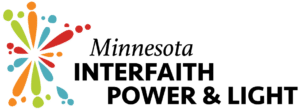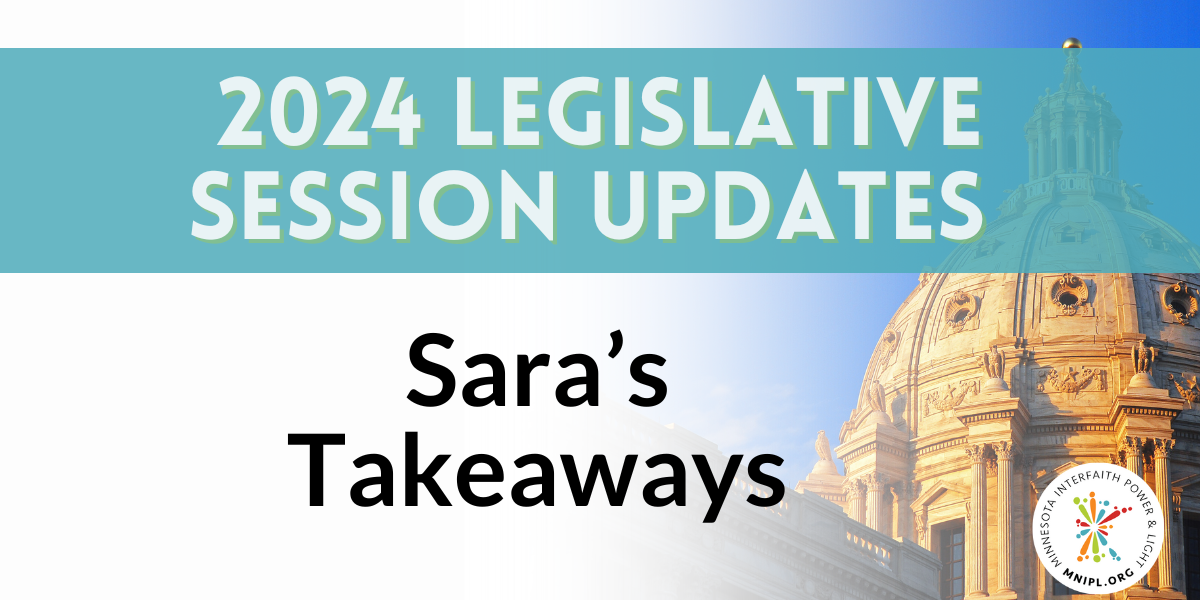2024 Legislative Session Update: Sara’s Takeaways
The second year of the biennium always flies by.
MNIPL started with a solid list of priorities this year.
→ Requiring state pensions to consider systemic risks like climate change when investing Minnesotans’ hard-earned dollars,
→ Establishing clean heat standards,
→ Ensuring Minnesota recycles electronic waste instead of throwing it away,
→ Recognizing the inherent rights of manoomin/psíŋ.
Perhaps it isn’t super great for me to remind you of these – because none of them passed. 😬
But actually it is good to remind ourselves of these: they are important and this work will continue. We learned a lot, grew our partnerships, discovered choke points and are honing our strategies. We are excited to keep going and hope you will be part of it.
Still, important strides were made for energy and the environment in 2024.
Here’s my short list of legislative high points from this session:
(For a more detailed breakdown of the Agriculture and Energy Omnibus, see this document.)
- Supporting Thermal Energy Networks: TENs for short because we’re going to be hearing more and more about them – these are a series of pipes connecting multiple buildings that use different sources of heating and cooling to reduce greenhouse gases. The legislature funded a suite of studies, projects, utility requirements, and planning grant funding for local governments. Sabathani Community Center in South Minneapolis received $6 million for a geothermal heating and cooling system anticipated to save the lion’s share of the center’s $27,000 per month energy bills. While not a network, its size makes it a notable retrofit – a nice complement to the incorporation of a TEN in the new Heights development in St. Paul (made possible by the MN Climate Innovation Finance Authority – something we did pass last year!)
- Improving Electricity Transmission: It wasn’t just about permitting reform. The legislature passed a number of bills that will help ease congestion and move renewable power where it is needed.
- Grid-enhancing Technologies: GETs find efficiencies on the existing grid by unclogging bottlenecks. They include tools like dynamic line rating, power flow controllers, topology optimization, and other hardware or software that reduce congestion or enhance the flexibility of the transmission system. I don’t really know about any of these things (See page 98 of this doc for definitions) – but really it is about making better use of what we have.
House bill author Rep. Larry Kraft said:
“We’ve all heard that we need to build more transmission lines. But these projects cost tens or even hundreds of millions of dollars and take years to build. GETs often cost hundreds of thousands of dollars, with deployment times measured in months. But they can increase capacity by 10 to 40%.”
- Interconnection: The legislature has instructed the Public Utilities Commission to develop a cost-share program when transmission upgrades are needed to get rooftop solar energy on to the grid. In addition, an ombudsman will be hired to help work through any interconnection disagreements.
- Solar APP+: Local governments can receive incentives (between $5K – $20K) for using this solar permitting software from the U.S. Department of Energy to automate the review of applications and issuance of permits for residential solar projects in utility service areas outside of Xcel Territory.
- Permitting Reform: The new Minnesota Energy Infrastructure Act replaces previous statutes on the permitting of energy, encompassing all forms of energy from coal to petroleum pipelines to solar and wind. Changes include creating two categories of review: Standard and Major, and eliminating certain steps through the permitting process. For more on permitting reform, see this document.
- Addressing Packaging Waste: The MN Zero Waste Coalition and many partners worked incredibly hard to pass a Packaging Waste Reduction Act sponsored by Senator Morrison and Representative Jordan. Minnesota has now become the fifth state to pass Extended Producer Responsibility (EPR) for packaging. Read more about it in this blog from Eureka Recycling.
A program for recycling boat wrap, sponsored by Rep. Larry Kraft, passed, too.
- Grid-enhancing Technologies: GETs find efficiencies on the existing grid by unclogging bottlenecks. They include tools like dynamic line rating, power flow controllers, topology optimization, and other hardware or software that reduce congestion or enhance the flexibility of the transmission system. I don’t really know about any of these things (See page 98 of this doc for definitions) – but really it is about making better use of what we have.
- Recognizing the Rights of Nature: While the Resolution recognizing the rights of Manoomin /Psíŋ didn’t move over the finish line this year, a growing movement has emerged. We trained dozens of volunteers to present a resolution to their party caucus. We were successful in moving through to one party’s state convention where it was adopted into the state platform: 68% of delegates voted to include it! We will continue to work on this legislation. Leanna Goose, Juventino Meza, Eóin Small and others will continue with outreach and organizing through the summer and fall. More to come on how to get involved in this campaign!
- Discerning Risk of Carbon Dioxide Pipelines: Pipelines carrying compressed carbon dioxide are new to Minnesota. The legislature is recognizing the risks that accompany them with new legislation.
- Carbon Dioxide Pipelines Study ($1 million): The Commission must contract with an independent third party to conduct a study that assesses the human health and environmental impacts that result from constructing, operating, and maintaining carbon dioxide pipelines; and 2) make recommendations regarding their regulation.
Among other things, the study must include:- potential human and environmental impacts of pipeline leak or rupture; and,
- greenhouse gas emissions resulting from carbon dioxide brought by pipeline to oil wells for enhanced oil recovery. The report is due November 1, 2026.
- Required Environmental Impact Statement for all Carbon Dioxide Pipelines. This wasn’t assured before. The EIS must be done according to the requirements of the Minnesota Environmental Policy Act.
- Carbon Dioxide Pipelines Study ($1 million): The Commission must contract with an independent third party to conduct a study that assesses the human health and environmental impacts that result from constructing, operating, and maintaining carbon dioxide pipelines; and 2) make recommendations regarding their regulation.
Of Note: Bills to Ban Carbon Dioxide Pipelines: While introduced late in session, bills to ban carbon dioxide pipelines in Minnesota, introduced in both the House and Senate, had significant support. (The House bill had 23 co-authors.)
Many important priorities by our wider coalition organizations gained ground but encountered barriers:
- Recycling electronic waste
- Removing the state ban on local governments placing bans on plastic bags
- Land back bills Of the 5 introduced, one passed (Mille Lacs County Land Return).
It’s important to remember that each Legislative Session is an opportunity to move our important work forward, but it’s not the only opportunity. Much of the work we need to do is in building coalition, doing outreach to Minnesotans who we know care about these issues, and continuing to discern where we need to spend time through our relationships with our communities. We’ll be talking more this summer about how we want to move forward, and we invite you to join us in that work!
Here’s what I’m excited about:
The solutions we’ve enacted – from the IIJA to the IRA, MNCIFA to the 100% Clean Electricity – are becoming real for people. We are starting to see change. Change like:
- 98 Clean School Buses for Minnesota.
- New developments that are fossil fuel free.
- Heat-pump installations in homes and businesses.
- Rural electric cooperatives taking advantage of clean energy funding.
We need to reach our tipping points to this transition as fast as possible. That takes all of us pushing with everything we’ve got. But momentum is growing. Change is visible. And we’re in it to win it.
Gratitude and blessings to you all for a beautiful summer. Thank you for all you do.

